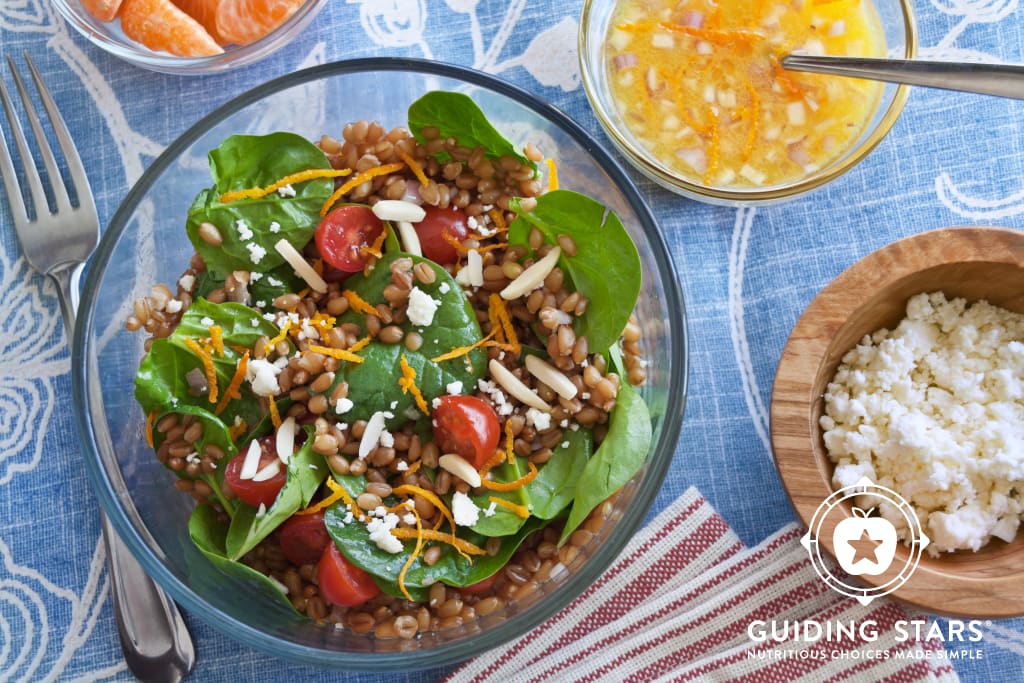
Last week, we talked about focus foods for nextovers. No matter how good the captain of your culinary starship is, it needs a good team. I took the approach of thinking about your vegetables as your mains, so we’re going to talk about proteins, grains, and seasonings today.
Proteins
Guiding Stars doesn’t give foods credits for protein. (Stop by on Wednesday to read our nutritionist’s in-depth explanation.) The short version is: quality matters more than quantity. Yes, we need protein. No, most of us in the U.S. aren’t running short on it. That being said, protein helps us feel full. Many of us don’t feel like we’ve have an actual meal if we can’t identify the protein. Include protein in your meal plans. Choosing proteins that earn Guiding Stars will help you avoid saturated fat and added sodium.
Lean Meat
I lean on skinless chicken breast and trimmed pork tenderloin, bought in bulk on sale. They can be cooked from frozen in very little time in a pressure cooker, or you can cook them in a batch and freeze in small portions to pull out at your convenience.
Fatty Fish
Fish rich with omega-3s are another great option. My fish preferences are wildly unsophisticated, so I mostly go for salmon on sale. Watch for Guiding Stars when buying any frozen seafood or meat. Many frozen options contain added sodium from brining. Fish defrosts pretty quickly. It you cook it in a foil packet, it tends to stay moist even if you need a longer cooktime. If you’re like me and routinely fail to give your fish quite enough defrost time, that’s a flavor saver.
Beans & Lentils
When choosing canned beans or lentils, watch for Guiding Stars to find the options with the lowest sodium. Drain and rinse canned options to lower the sodium before you use them. Dried options are cheaper, and can easily be cooked up in a pressure cooker or slow cooker. I portion mine out in recycled glass peanut butter jars to freeze (leaving a generous inch of headroom) for easy microwave defrosting.
Grains
Whole grains contain more fiber and more nutrients than can be removed in processed grains. Guiding Stars credits foods for containing whole grains. Here’s what I routinely use from my own pantry.
Wheat Berries & Barley
You can buy these in bulk pretty cheaply. Fun project: you can buy milling blades for most blenders and food processors and make your own flour by grinding wheat berries. I mostly just boil them until tender (which takes a good hour on the stovetop, less in the pressure cooker), drain them, and freeze them. I generally freeze them flat on a baking sheet lined with a silicone mat and transfer them to a freezer bag so I can easily measure out just what I want to use.
Rice & Quinoa
Brown rice is a little more nutritious than white rice. I keep the instant on hand, though, because I never want to fuss with the cooktime of regular brown rice. Texturally, sometimes I want white rice, which also earns Guiding Stars, so I keep jasmine rice on hand too. Quinoa falls in this category for me as well, as all three cook up quickly. I almost always cook these to go with the meal fresh the night I want them.
Seasoning
Added sugars, added sodium, and saturated fat are all on the list that Guiding Stars debits food for. I use them in my cooking, but I try to use less of them. This is the toughest piece for many of us, because we’re used to foods that have a lot of all three. A fun thing, particularly relevant to salt, is that our tastebuds change over time. I didn’t realize just how much mine had changed cooking with Guiding Stars until I started making solid food for my infant. Infants shouldn’t have any added sodium, and his salt-free food was shockingly tolerable to me. It takes time to adjust, though, and a couple of flavoring tricks helped me transition.
Aromatics
Onion, garlic, ginger, carrot, celery, leeks…there’s a world of produce-based ingredients that bring massive flavor to a dish. You can fry them lightly in a heart-healthy fat (like olive oil) or simmer them in a tiny bit of water to pull the flavors out to work in your dish. Play with new ones when you get the chance and use a little more than usual.
Salt-Free Spice Blends
I’ve been working on the Guiding Stars recipe database for the better part of a decade at this point: my spice collection is ridiculous. And you know what I cook with more often than not? Blends. Even if I have all the components for three different kinds of harissa in my various jars, I typically grab a store-bought option. It’s speedier and the balance is not subject to my human errors.
Acid
If you think your dish tastes flat, add a little acid before you add more salt. Lemon juice, lemon zest, vinegar of any kind, sumac powder, or even citric acid if you *ahem* have an awkwardly large quantity sitting around from a cheese making kit you were gifted and only used twice. (Be careful with that last, though. A very little goes a loooong way. From my guacamole disasters to your ears.) I can’t explain the science, but it works.
Those are my top tips on what to stock to support a nextover approach to cooking. Be sure to stop back in next Friday to explore cooking techniques that are brilliant for giving your leftovers a new mission.